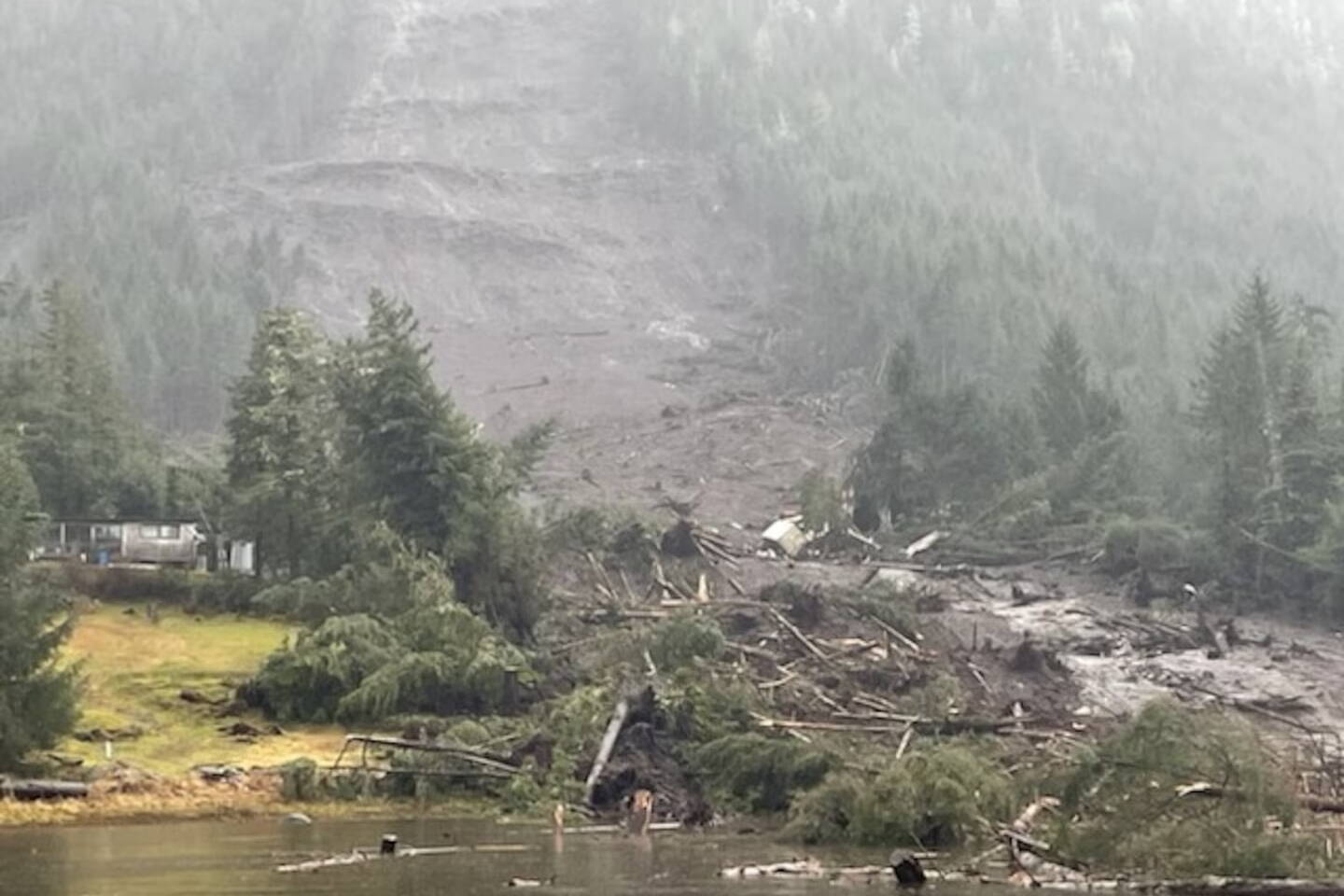This is a developing story.
One female juvenile and two adults were killed, and three more people are missing as of Tuesday evening following a massive landslide Monday night in Wrangell that destroyed three single-family homes, according to officials.
The missing people include two juveniles and one adult, said Austin McDaniel, a spokesperson for the Alaska State Troopers, during an hour-long media briefing that started at 2:30 p.m. Tuesday. The female juvenile killed was found during what McDaniel called an initial hasty search, with the two adults found Tuesday afternoon.
“This afternoon a drone operator located two deceased adults in the slide area,” an AST announcement at 5:15 p.m. states. “The two bodies were recovered from the slide area this evening. At this time, Troopers believe that two juveniles and one adult are still unaccounted for in the slide area. Search and rescue K9 teams from SEA Dogs in Juneau and Wrangell Search and Rescue are actively searching on the ground. No further updates are expected tonight on the search and rescue effort.”
One adult female was rescued Tuesday morning, and is receiving medical care and in good condition, McDaniel said.
A large-scale search and rescue operation, as well as land stability assessments of the area, are ongoing by a multitude of agencies, according to officials speaking during the press conference. Gov. Mike Dunleavy issued a state disaster declaration for Wrangell on Tuesday morning.
[Storm causes disruptions in Juneau; landslide in Wrangell hits 3 homes, kills at least 1 person]
The Wrangell landslide occurred at 8:51 p.m. Monday at mile 11 on Zimovia Highway, in the midst of a storm where more than three inches of rain fell for a 24-hour period ending Tuesday morning, according to official reports.
About 20 to 30 people in the area between miles 11 and 13 on Zimovia Highway have been displaced from their residences, where a mandatory evacuation order is in effect, said Wrangell Borough Manager Mason Villarma.
“We have crews doing door-to-door evacuation measures so people have been notified,” he said.
Reports of people believed to be missing in the slide area should be reported to the Wrangell Police Department at (907) 874-3304.
The landslide also cut off the road to about 75 households. Water taxis are being used to transport people from the area, according to an Alaska State Troopers bulletin.
Villarma also urged residents to “be aware of your surroundings and the potential for other slides to occur with the weather that’s happening in the region.”
“If you believe there’s an imminent threat to life, health and safety, please dial 911,” he said.
Behavioral health services are being offered through the local SEARHC clinic, with other assistance also available such as the Wrangell Fire Department providing fuel for generators for people without electricity, Villarma said.
“This most certainly is a trying time for our community,” he said. “But as always this little town of ours has banded together and shown quite some resilience.”
The landslide was nearly 500 feet wide, although the volume of material released is not yet known, said Shannon McCarthy, a spokesperson for the Alaska Department of Transportation and Public Facilities. She said department officials conducted a flight survey over the hillside earlier on Tuesday.
“Apparently the upper slope is becoming more stable, which is great news, it was pretty active over the night,” she said.
A drone with thermal detection, heavy equipment operators on the ground, environmental analysts mapping out what to do with the debris, and two U.S. Coast Guard aircraft and a cutter vessel are among the resources currently deployed in the rescue and assessment operations, according to officials.
McCarthy said it’s too early to know how long it will take to remove the debris from the area, but it could take weeks.
Satellite and other imagery will also be used to assess ongoing slope and soil conditions, said Barrett Salisbury, a geologist for the Alaska Department of Natural Resources. He said there currently isn’t equipment in place for data mapping and monitoring of landslide risks in the area.
“Without specialized instruments in place long before an event like this it’s virtually impossible to predict this kind of catastrophe,” he said.
There are numerous signs of debris flow that caused the landslide that people can watch for during conditions such as those in Wrangell, “particularly if the weather continues to stay wet,” Salisbury said.
“Those would be new springs or seeps of water flowing over the ground where it didn’t use to flow, or saturated ground where it was otherwise not wet before the major storm started,” he said. “New cracks or bulges in the ground, streets or sidewalks tilting, if you have a porch that’s pulling away from the house. Similarly, if soil around the foundation of your home is pulling away from the foundation those are all big warning signs.”
Unusual tilting of trees or telephone poles, and bulging of retaining walls and fences are exterior warning signs, Salisbury said. Inside residences, doors not shutting properly or stuck windows are indicators.
”One of the biggest signs that people need to be listening for are noises like rumbling trees, cracking, boulders knocking — especially if that noise starts as a faint noise, and gets louder and louder and louder,” he said. “So what to do, if you are able to, it’s advisable to leave the area if you can, help your neighbors, evacuate elderly folks, those with children, or those with lots of pets.”
If people are unable to evacuate a residence if danger of a landslide impact is imminent “the best thing to do is to curl into a tight ball and cover your head,” Salisbury said.
• Contact Mark Sabbatini at mark.sabbatini@juneauempire.com or (907) 957-2306.

